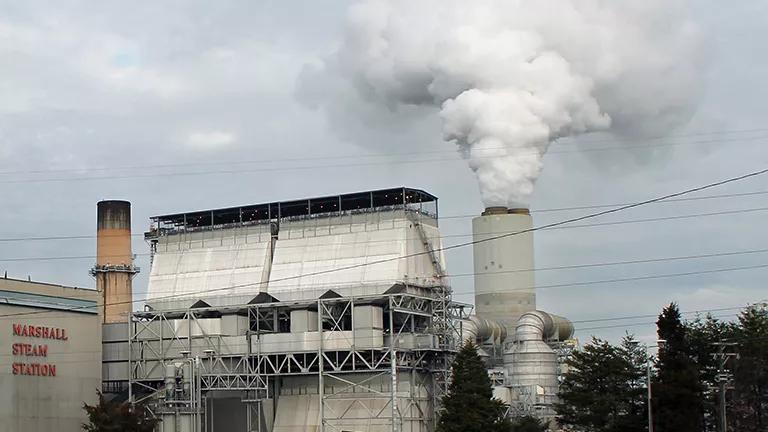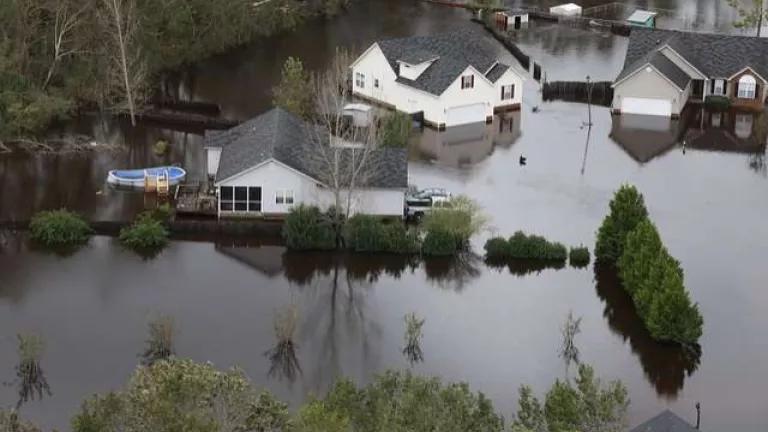Dorian, Florence, Etc: The World at One Degree of Warming
Recent flooding and hurricanes have made it clear that climate change is a clear and present danger.

Hurricane Dorian made landfall over Cape Hatteras, N.C., at 8:35 a.m. EDT Friday, Sept. 6, 2019.
It’s little solace to hear that achieving the most optimistic goals for emissions reductions means “we’ll avoid the worst impacts of climate change,” if the worst thing that could happen has already happened or, for many, has happened multiple times.
We are seeing the all-too-real impacts of climate change on an all-too-regular basis. Climate change now unequivocally poses a dual challenge: we must focus on how we are going to cope with the storms, wildfires, droughts, etc. that are the real world manifestations of climate change while we also dramatically reduce the emissions that are its root cause.
Dorian reached North Carolina just a week shy of Hurricane Florence's one-year anniversary and is the third hurricane to batter North Carolina since 2016, when Matthew made landfall. For South Carolina this is the fifth year in a row where large parts of the state have been declared disaster areas, starting with a 1,000 year flood in 2015 and with Matthew (2016), Irma (2017), Florence (2018) following each year.
These states are hardly alone. Many other places in the United States have experienced multiple climate-driven disasters in recent years including Florida (Hurricanes Irma and Michael), California (wildfires in 2017 and 2018), Texas (Harvey in 2017 and 500 year floods in the two subsequent years), and Puerto Rico and the U.S. Virgin Islands (Irma and Maria in 2017 and Dorian in 2019). I’m undoubtedly omitting many more.
The growing frequency and magnitude of climate-driven disasters is already far outpacing our current efforts to adapt to the consequences. This “adaptation and resilience gap” will grow dramatically, even under the best-case climate change scenarios (warming of 1.5o C – 2.0o C), absent concerted efforts by communities, states, and the federal government to prepare for future climate impacts and adapt accordingly.
In the aftermath of 2018's Hurricane Florence, the Governors of both North and South Carolina woke up to the need to close the adaptation and resilience gap in their states.
In South Carolina, Governor McMaster formed the Floodwater Commission to examine the options available to the state to safeguard itself from the widespread flooding that is now an annual occurrence. The commission has released a summary of its findings and comments are being accepted until October 24.
In North Carolina, Governor Cooper issued Executive Order 80, which has set in motion efforts to identify ways of reducing the state's emissions and its impact on the climate as well as, "integrate climate adaptation and resiliency efforts into their policies, programs, and operations.” The Executive Order established the NC Interagency Climate Council to guide this work, including development of the Climate Risk Assessment and Resilience Plan. NRDC has been supplying a great deal of information to the state in support of this effort.
These efforts have been undertaken because recent flooding and hurricanes have made it clear that climate change is a clear and present danger, not a potential future threat that only exists in charts and graphs.
In many ways, we’ve been lulled into thinking that the rising risks of hurricanes, floods, wildfires, droughts, etc. are a future impact of climate change that can be mostly avoided or avoided entirely. There’s a temptation to think, “If we keep emissions down and hold warming to 1.5o C – 2.0o C, we’ll avoid the worst impacts,” which to some sounds like, "we’ll avoid most of the impacts."
But the impacts of climate change look awfully bad right now to those in the Carolinas who have been affected by Dorian (and Florence, Matthew…) and are faced with rebuilding their home or repairing damage from a major flood disaster for the third, fourth, or fifth time in five years.
It’s little solace to hear that achieving the most optimistic goals for emissions reductions means “we’ll avoid the worst impacts of climate change,” if the worst thing that could happen has already happened or, for many, has happened multiple times.
That's why efforts like those underway in North and South Carolina are encouraging. It illustrates that states, even those who have not had a strong track record on climate action, recognize the situation they are facing and are committed to finding solutions. When it comes to closing the adaptation and resilience gap, the federal government (even Congress and the Trump administration!) as well as states and communities across the nation, are taking proactive steps to anticipate the impacts of climate change and prepare for them.
Now we need to take much bigger steps and take them much more quickly.




